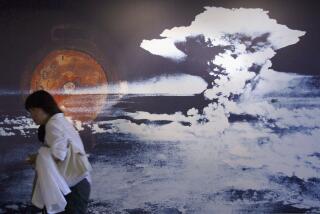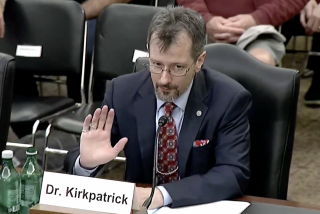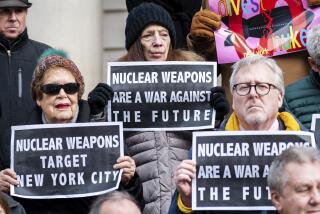Nevada A-Blast Set--and Soviet Scientists Have Front-Row Seat
- Share via
MERCURY, Nev. — American and Soviet scientists, in unprecedented cooperation at one of the most sensitive U.S. defense facilities, are preparing to demonstrate ways to verify compliance with unratified nuclear test-ban treaties signed in the mid-1970s.
The technicians, working together at the Nevada Test Site since April, have been sharing information and technology aimed at verifying compliance with the 1974 Threshold Test Ban and 1976 Peaceful Nuclear Explosions treaties.
A successful demonstration of the two nominated technologies--first with a 100- to 150-kiloton explosion set for Wednesday in Nevada, and again with a blast in four weeks at the Semipalatinsk Test Site in Soviet Central Asia--could even allow new treaties.
At both events, both sides will share the data gathered using two different verification technologies--teleseismic, which detects blasts and can estimate their strength over great distances, and hydrodynamic, which measures the size of blasts from a few yards away. Each side will test both methods.
Demonstration of Options
The goal is to demonstrate different options from which the two nations may choose to assure compliance with test-limitation treaties; the events also are designed to show that compliance can be verified without revealing secrets not required to be disclosed, such as special designs.
The demonstrations will mark the first time each nation has been allowed to watch the detonation of a nuclear device at the other’s secret proving grounds--an idea that U.S. officials here said they considered unthinkable until very recently.
“Historical, unprecedented, remarkable all describe the efforts made behind this agreement,” said Troy E. Wade, the acting assistant secretary for defense programs at the Department of Energy, which operates the Nevada Test Site and builds the nation’s nuclear bombs.
Unprecedented Events
“Most of the things happening between the two sides . . . have never happened before,” said C. Paul Robinson, U.S. delegation leader at the Nuclear Testing Talks in Geneva. The 45 Soviet personnel laboring in Nevada declined to be interviewed, but Robinson said, “Each side is surprised at how well things are going.”
The demonstration is intended to ease doubts about compliance with treaties limiting the size of underground nuclear tests, the only kind permitted by the 1963 Limited Nuclear Test Ban Treaty. Concern about the accuracy of long-range verification technologies and Soviet reluctance to permit on-site verification blocked Senate ratification of the two mid-1970s treaties and undercut support for new, stricter agreements.
Although both nations have promised to comply with the constraints of those earlier pacts--which limit tests to 150 kilotons, equivalent to about 150,000 tons of TNT--they both have at times inaccurately challenged one another over suspected violations. This has led the United States to conclude that neither has a reliable long-distance verification technology.
Soviet officials last year agreed to reconsider their opposition to on-site test-ban verification if it is demonstrated to be “non-intrusive”--that is, if the method used to measure the explosive yield, or power, of bombs does not also reveal secrets about bomb construction or composition.
The Soviets believe partial test bans can be verified teleseismically, with seismographs and other earthquake-research equipment to measure tremors caused by underground nuclear blasts thousands of miles away. The United States argues that this is not accurate enough to verify compliance with the limits of either treaty.
U.S. officials prefer hydrodynamic monitoring, but that requires inspectors to visit sensitive nuclear-testing grounds and install electronic sensors just a few meters away from underground explosion sites--a degree of intimacy with which neither side has felt comfortable in the past.
In July, 1986, scientists from both countries met in Geneva to exchange data on their preferred methods. About 16 months later, formal political delegations arrived to negotiate “protocols,” or guidelines, under which the two limited test-ban treaties could be verified. An agreement setting up the demonstration was signed during the Moscow summit last May.
By then, however, Soviet technicians already were working at the test site, 65 miles into the desert north of Las Vegas. They reside in Mercury, a Spartan government outpost, and commute 35 miles further into the desert to Site 19-X, a gathering of drill rigs, earthmovers and trailers on nuclear-pockmarked Dead Horse Flat at the north end of the 1,350-square-mile proving grounds.
While the Soviets have been working at the secretive facility, the United States has conducted six underground nuclear tests. Although the visitors were restricted to Mercury, U.S. officials said their presence anywhere on the outpost during a test made history.
One Person’s Perspective
“I have spent the last 40 years developing nuclear weapons to protect this country,” said Wade. “Protect from whom? Principally, the Soviet Union. Now, suddenly, here they are. There is definitely an emotional response to that.”
Despite these concerns, the only untoward incident reported so far has involved Americans in the Soviet Union. The Washington Post reported last week that on July 17, Soviet inspectors discovered several contraband items--tools, wire and samples of soil and rock from the Soviet test site--in crates of personal belongings packed by one U.S. official and two employees of private companies under contract to the U.S. government.
No Return Trip
The Soviet Union expressed concern over the incident and the State Department said Friday the three Americans will not be among those returning to the test site next month. U.S. officials described the incident as stemming from a misunderstanding.
Despite this, Wade and others, even some hard-liners skeptical of treaties with the Soviet Union, said the exchange agreement already has opened a new era in the ability of both sides to assure compliance with treaties already signed--and, perhaps, with those yet to be negotiated.
Among the information exchanged was seismic, geologic, geographic and size data on five underground nuclear blasts conducted by each side within the last decade and actual core samples showing the exact geology of the areas in which each nation now conducts underground tests. This information should allow both sides to assess the accuracy of their current seismic verification methods and “fine-tune” their equipment for even better performance.
Called Unprecedented
“We overuse the word unprecedented , but that exchange of data on June 28 certainly fits in that category,” Wade explained. “We have never seen Soviet yields before, (and) . . . the cores we brought back were the first time we have ever seen Soviet geological data.”
Further information, including data on the accuracy of each nation’s treaty verification capabilities, will be made available after the two demonstration blasts are conducted.
Nick C. Aqualina, manager of the Department of Energy’s Nevada Operations Office in Las Vegas, said the $25-million test is fairly inexpensive when compared to the $10- to $60-million cost of the 15 to 20 other nuclear blasts conducted each year at the test site. The Wednesday explosion will have no other purpose than to demonstrate the verification monitors, he added.
Beyond their amazement at the demonstration itself, known officially as the Joint Verification Experiment, American participants often express surprise at how well the two technical teams cooperate.
Example Cited
A frequently cited example was the Soviets’ invitation to let the U.S. team use its own drilling rig to bore a hole at Semipalatinsk to the precise standards requested by the Americans.
“Picture this: a flight of C-5As--American military transports--not only flying across thousands of miles of Soviet territory, but then being permitted to land at Semipalatinsk,” said Robinson. “I still can’t believe it.”
At the same time, many safeguards born of skepticism have been written into the 105-page agreement laying down the rules of the demonstration.
Test site security is harsh. At the Nevada Test Site, Americans are not allowed inside an orange plastic fence around the Soviet trailer camp unless invited. Cables linking Soviet test gear with the nuclear device buried 2,020 feet below the desert also are fenced off; nearby signs warn: “Security Area. Deadly Force Authorized.”
Personal Belongings
Unrestricted inspection of personal belongings also is included, a clause that paid off with the discovery of unauthorized materials collected by U.S. team members last month.
Despite such precautions, workers said the atmosphere has been both relaxed and cooperative, for the most part.
So far, however, the two nations continue to differ on which verification method they prefer.
The Soviets prefer a teleseismic method relying on seismometers to measure ground vibrations and filter out earthquakes, industrial explosions and other non-nuclear events. Results are run through mathematical formulas to estimate the size of the nuclear blasts.
Scholars Recruited
The Soviets contend that this science can accurately verify compliance, and some U.S. scientists agree. To demonstrate the ability of high-frequency seismology, scholars from several U.S. universities were recruited by the Natural Resource Defense Council, a New York-based environmental group, to work with the Soviet Academy of Sciences on joint experiments in Nevada and Khazakhstan, the Soviet republic in which the Semipalatinsk Test Site is located.
They said their tests with conventional explosives demonstrated the ability to detect nuclear explosions, distinguish them from earthquakes and industrial blasts, and estimate the explosive yield, all from hundreds of miles away from the test sites. They have returned to their monitoring sites in California and Nevada to try to repeat the results during the nuclear explosion.
Viewed as Unreliable
The U.S. government says that teleseismic methods show promise but are not yet reliable to verify treaties because they can overestimate or underestimate explosive yield by as much as 100% and are subject to evasion by sophisticated masking techniques.
Hydrodynamic testing, the method preferred by the United States, involves installing coaxial cable in a hole a few yards from the underground nuclear bomb. When triggered, the blast destroys the cable, starting near the bomb and working toward the surface. Scientists measure the speed by which the cable is thus shortened to estimate the speed of the explosion’s shock wave, which they then apply to a mathematical formula to calculate yield.
“The hydrodynamic systems are very accurate,” Robinson said. “They leave little opportunity, if any, to spook, hide, or conceal the actual yield of the experiment.”
Secret Outposts
Hydrodynamic technology is a problem, Wade said, in that it requires giving foreign technicians access to secret outposts. He said this not only disquiets military leaders, it is expensive, time-consuming and generally bothersome. He said that for this reason, the United States continues to pursue other ideas, including a refined teleseismic capability.
Optimists among scientists in the field believe that some combination of the two techniques--seismic and hydrodynamic--may someday permit stricter test bans, perhaps even a comprehensive agreement forbidding nuclear tests altogether.
“It certainly will give us data we have never had before,” said Wade, who is skeptical about the verification aspects of a comprehensive nuclear ban but upbeat nevertheless. “It will tell us where we stand, and give us better data to see where we go next.”
More to Read
Sign up for Essential California
The most important California stories and recommendations in your inbox every morning.
You may occasionally receive promotional content from the Los Angeles Times.










